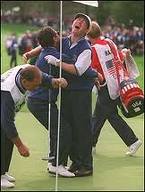 To read all the trash-talking, captain-bashing, and saber-rattling, a reasonable assumption would be that every golf fan’s most vivid Ryder Cup memory would necessarily involve his or her team winning. Of course, there are no absolutes.
To read all the trash-talking, captain-bashing, and saber-rattling, a reasonable assumption would be that every golf fan’s most vivid Ryder Cup memory would necessarily involve his or her team winning. Of course, there are no absolutes.
This reporter’s fondest memory goes back to the 1995 installment, played at Oak Hill, in Rochester, New York. Several other American golf writers and I were lucky enough to be at Portstewart Golf Club, on the Antrim coast, in Northern Ireland. Following a round on the epic links course designed in 1894 by Willie Park, we repaired to the pub to watch the final day’s singles competition with the predominantly Irish crowd.
Never misidentified as a Western European socialist, I was naturally rooting for the Yanks and was in that regard disappointed by the 14 ½ – 13 ½ victory forged by the European side. Still, under the circumstances, the experience was a lot more fun the way it turned out.
Coming back from a two-point deficit starting the day’s singles competition, the upset was capped by Irish journeyman Philip Walton, whose bogey on the final hole of his match against Jay Haas clinched the cup. Needless to say, Walton’s compatriots at the bar went berserk.
Having lost the previous two competitions and 23 of 29 (there were also two ties), the Europeans had been considered prohibitive underdogs, especially playing at a stateside venue. So the patrons in the Portstewart clubhouse were predictably and justifiably delirious over the outcome.
But their elation seemed to include almost no “demonstrating” or gloating – they were simply proud of their boys for beating a team that, on paper, appeared to be superior. The joy was infectious, nationality notwithstanding: It was easy to relate to our hosts’ excitement.
And since any contest is diminished when the same side wins virtually every time, the oft-repeated phrase – that the European win would be “good for the game” – seemed perfectly valid.
Viewed from the standpoint of the Ryder Cup’s immensity (cf., the money it generates), it’s impossible to argue otherwise. (It’s also true that we Americans probably viewed the result as an aberration — and in that sense easier to take — than as a precursor of the role reversal to come.)
Bigger isn’t uniformly better, however, and the difference between wanting to win and expecting to win doesn’t always bring out the best in people. All the hand-wringing, particularly in the press, about “what went wrong” that accompanies a loss is unseemly and borderline unsportsmanlike.
Speaking of which, my eager anticipation of the riveting, pressure-packed golf to be played during the Ryder Cup is inevitably tinged with apprehension over obnoxious behavior by spectators, competitors, or, even worse, both.
Accordingly, two alternative strategies for viewing the upcoming Ryder Cup come to mind. One is to find some fans inclined, for whatever reason (excluding criminal insanity) to support the Europeans. Meet them at a bar and cheer like hell for the red, white, and blue, while they do the same for their team, but always bear in mind that which makes golf different from, say, mixed martial arts.
Ideally, your experience will be as copacetic as mine at Portstewart, whatever the denouement.
The second approach is the Jim model, named for an old schoolmate who was an inveterate Pittsburgh Steelers fan in the team’s “Steel Curtain” heyday. Invited to watch the Super Bowl on a large-screen television – a novel device in the day – he politely declined, opting instead to “lock myself in my apartment.”
“That way,” Jim explained, “I can throw projectiles at the screen, shout expletives and epithets at will, and generally behave like an ass. But in private.”
# # #
